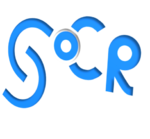Difference between revisions of "SOCR Intro UMich Fall 2019"
(→References) |
|||
| (2 intermediate revisions by the same user not shown) | |||
| Line 50: | Line 50: | ||
* [http://predictive.space Data Science and Predictive Analytics (DSPA) Website: http://predictive.space] | * [http://predictive.space Data Science and Predictive Analytics (DSPA) Website: http://predictive.space] | ||
* [http://socr.umich.edu/html/SOCR_Funding.html SOCR Funding] | * [http://socr.umich.edu/html/SOCR_Funding.html SOCR Funding] | ||
| − | * [ | + | * [http://wiki.socr.umich.edu/index.php/SOCR_Intro_UMich_Fall_2019 This summary, links and materials are available online: http://wiki.socr.umich.edu/index.php/SOCR_Intro_UMich_2019]. |
Latest revision as of 15:40, 12 August 2019
Contents
SOCR News & Events: Introduction to UM Health Analytics, SOCR, MIDAS, NGP
Logistics
- Event: August 29, 2019 New School of Nursing Faculty Orientation
- Place/Time: 11:20 AM, 400 N. Ingalls (NIB 1330)
- Presenter: Ivo D Dinov
SOCR
The Statistics Online Computational Resource (SOCR) designs, validates and freely disseminates knowledge. SOCR provides portable online aids for probability, statistics, and health science education, promotes technology-enhanced instruction, supports efficient statistical computing, and advances predictive big data analytics. The SOCR infrastructure includes a repository of interactive applets, computational webapps, graphing tools, instructional resources, challenging case-studies, learning materials, and many curricular components.
SOCR Services
- Consultations on data analytic problems, computational challenges, statistical methods
- Methodological support for research studies, grant applications, and publications,
- Technology support for data management, wrangling, visualization, and interrogation of complex, multi-source, heterogeneous biomedical and health data,
- High-performance, large-memory computing services, and
- Biomedical informatics, health analytics, and machine-learning classification, prediction and clustering.
Examples of specific SOCR Resources
SOCR Tools are used for capturing and interrogating biomedical and healthcare data. These include SOCR Analytical Toolkit (SOCRAT), SOCR Data Dashboard Webapp, SOCR PubMed Navigator, Motion Charts, Randomization, Resampling and Simulation Webapp Violin Chart, Interactive (3D) Bivariate Normal Distribution Calculator webapp, Normal Distribution Calculator, Distributome Probability Calculators, Virtual Experiments, Simulators, Probability Distributome Navigator, Econometrics Webapps, XTK/HTML5 Brain Viewer and BrainBook Painter, DataSifter: Sharing and Obfuscation of Sensitive Data, CBDA: Compressive Big Data Analytics, 2D Interactive Voronoi Tessellation App, SOCR t-SNE Dimensionaltiy Reduction (TensorBoard) UKBB Machine Learning Modules, SOCR GitHub Resources, Apps, Code, Tools, and other Services.
- SOCR Navigators
- SOCR Datasets and Challenging Case-studies
- Electronic Textbooks: Probability and Statistics EBook, Scientific Methods for Health Sciences, Data Science and Predictive Analytics
- Hands-on interactive visualization of extremely high-dimensional data (learning module and webapp)
- SOCR News & Events
- SOCR Global Users
SOCR Team
Health Analytics Collaboratory (HAC)
The SoN Health Analytics Collaboratory (HAC) is one of several SoN Research Intensive Entities (RIEs). HAC serves as an open incubator for collaboration and digital scholarship that emphasizes team-based transdisciplinary data science and advanced health analytics. A core mission of HAC is to foster integration of innovative research, development, education and training, and outreach in data and health sciences.
Michigan Institute for Data Science
The Michigan Institute for Data Science (MIDAS) catalyzes data science at the University of Michigan through support for faculty, research, education and training, and industry engagement. MIDAS offers grant support, collaboration opportunities, graduate data science certificate training, online MOOCs, data science seminars, and other transdisciplinary activities.
Neuroscience Graduate Program (NGP)
The UM Neuroscience Graduate Program was established in 1971 and is one of the oldest continuously run grad neuroscience program in the nation. NGP includes 70+ grad students and 150+ trans-collegiate faculty performing research across the breadth of the neuroscience field. There are many opportunities to engage with program faculty, students and scholars.
References
- SOCR Publications
- Dinov, ID, 2018. Data Science and Predictive Analytics: Biomedical and Health Applications using R, Springer, Computer Science, ISBN 978-3-319-72346-4.
- Data Science and Predictive Analytics (DSPA) Website: http://predictive.space
- SOCR Funding
- This summary, links and materials are available online: http://wiki.socr.umich.edu/index.php/SOCR_Intro_UMich_2019.
- SOCR Home page: http://www.socr.umich.edu
Translate this page:

